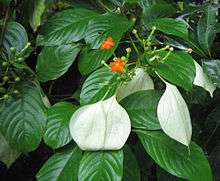Mussaenda frondosa
Mussaenda frondosa, the wild mussaenda or dhobi tree, is a plant of family Rubiaceae. It is a shrub that grows to about 1.5–2 m (4 ft 11 in–6 ft 7 in) tall. Like all other Mussaenda species, they have a large prominent white petaloid sepal in their flowers.[2]
| Mussaenda frondosa | |
|---|---|
 | |
| Scientific classification | |
| Kingdom: | Plantae |
| Clade: | Tracheophytes |
| Clade: | Angiosperms |
| Clade: | Eudicots |
| Clade: | Asterids |
| Order: | Gentianales |
| Family: | Rubiaceae |
| Genus: | Mussaenda |
| Species: | M. frondosa |
| Binomial name | |
| Mussaenda frondosa | |
| Synonyms[1] | |
| |
Appearance
The shrub may also grow as a scandent climber. The flowers are clusters of orange-yellow tubular flowers with one of their five sepals enlarged into a white petal-like form, set among pale green, oval leaves; berries follow the bloom. The erect, branching stem has a shrubby crown.
Range
Mussaenda frondosa is native to India, Nepal, Sri Lanka, Cambodia, Vietnam, Malaysia and Indonesia.

Fruit
References
- "The Plant List: A Working List of All Plant Species". Retrieved 23 January 2015.
- Jayaweera, Don M. A. (1963). "THE RUBIACEOUS GENUS MUSSAENDA: THE MORPHOLOGY OF THE ASIATIC SPECIES". Journal of the Arnold Arboretum. 44 (1): 111–126. ISSN 0004-2625. JSTOR 43781456.
This article is issued from Wikipedia. The text is licensed under Creative Commons - Attribution - Sharealike. Additional terms may apply for the media files.